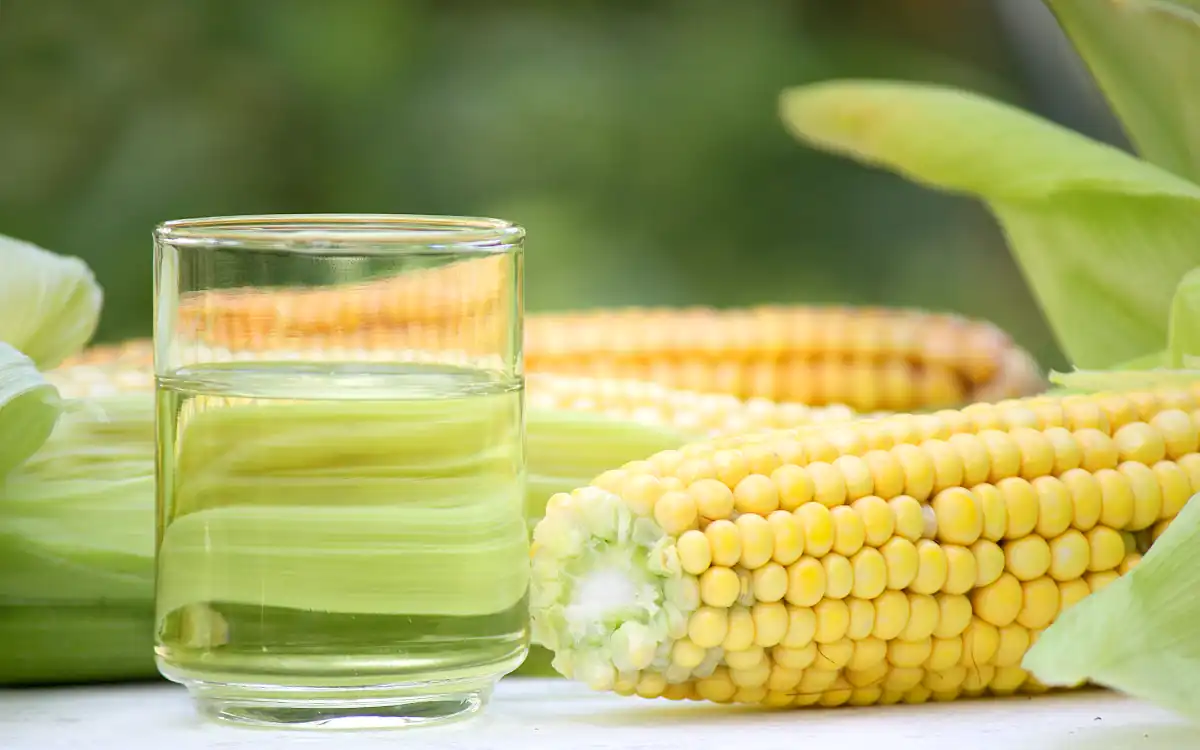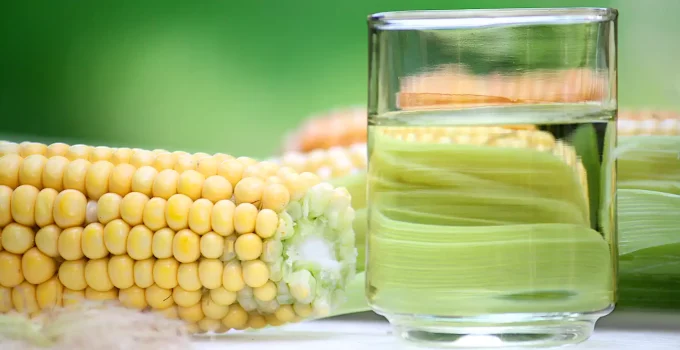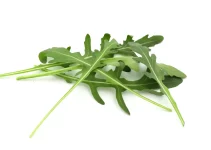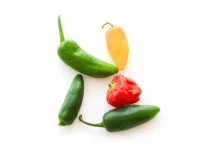There are a few major things to be aware of when we’re looking for the best substitutes for corn oil.
First of all, corn oil is a vegetable oil that is neutral in taste.
Thus, if you’re looking for corn oil substitutes that you want to have the same neutral taste, then you’ll have to choose between canola oil, sunflower oil, vegetable oil, peanut oil, safflower oil.
Another aspect we must pay attention to is that corn oil has a smoke point at 450 degrees Fahrenheit (230 degrees C). That’s a high smoke point, which means that it’s very good for frying and deep-frying.
Other oils with similarly high smoke points are: sunflower, canola, peanut, avocado, sesame, mustard, and palm oil. These are perfect for frying and cooking at temperatures that exceed 400 degrees F.
Moreover, corn oil is frequently used in commercial kitchens because it’s cheap.
Thus, if you’re looking for the best substitutes for corn oil that will be just as cheap, you should choose canola, vegetable, sunflower, safflower, and palm oil.
Table of Contents
15 Best Substitutes for Corn Oil

As you saw in my introduction, I will first focus on the vegetable oils that have a lot of things in common with corn oil.
These will be: canola, safflower, sunflower, vegetable, peanut, avocado, sesame, and palm oil.
Next, we’ll move on to talking about one of my favorites: olive oil.
I also want to introduce you to mustard oil, which is made from the seeds of the mustard plant. It’s going to be a novelty for some to learn that mustard oil is indeed an oil that can be used for the same purposes we use corn oil.
Last but not least, we don’t have to go for vegetable substitutes for corn oil. We can choose animal fats: butter, lard, bacon grease, beef tallow.
1. Canola oil
For plenty of people one of the best substitutes for corn oil is going to be canola oil.
That’s because these two have plenty in common: neutral taste, high smoke point above 400 degrees F, and low prices.
This is a vegetable oil derived from the rapeseed plant. The canola plant is a cross-bred version of the rapeseed plant. So, even if we say that it comes from the canola plant or the rapeseed plant, both are true.
Canola oil and many of the other vegetable oils also work in baking and for making desserts because they have a neutral flavor.
Thus, if you’re looking for corn oil substitutes for making desserts, you can absolutely use canola oil.
But you can also use safflower, sunflower, avocado, and palm oil for making desserts. Or use butter if you want to use animal fats.
2. Safflower oil
The second most popular choice for the best substitutes for corn oil might be safflower oil. It depends just how expensive it is. If you have a bigger budget you might prefer olive oil instead.
It comes from the seeds of the safflower plant, which is completely different from the sunflower plant.
It’s perfect for frying, deep-frying and cooking because it has a high smoke point around 510 degrees F.
3. Sunflower oil
We shouldn’t confuse safflower and sunflower oil, although they have a lot in common, including similar prices.
They’re also two of the best substitutes for corn oil.
Sunflower oil is one of the most used in many parts of the world. There are parts of the world where sunflower oil is the cheapest option and that’s what makes it so popular in those areas.
It also has a neutral flavor but it works really well in many salads. It’s not as good as olive oil but it works nicely as a cheap substitute.
Sunflower also has a high smoke point, at about 450 degrees F. It can be used for frying, deep frying, for cooking all types of savory dishes and for desserts.
4. Vegetable oil
You might come across bottles that only bear the name vegetable oil. That stands for soybean oil, that’s the only ingredient you’ll find written on the packaging.
It has a neutral flavor, a high smoke point of about 450 degrees F, it’s great for cooking, frying, deep frying, desserts, and it might be one of the cheapest options where you live.
All that makes it one of the best substitutes for corn oil.
5. Peanut oil
Peanut oil is absolutely amazing.
However, there’s just one big problem: it can be a bit more expensive than the other types of vegetable oils that work as the best substitutes for corn oil.
Moreover, peanut oil is not used by many restaurants in order to avoid triggering customers’ allergies. Thus, it’s a lot more limited for commercial purposes.
The amazing thing about peanut oil is its really high smoke point, about 450 degrees F.
Does it have a strong flavor? Not exactly, it has a light, nutty flavor but you won’t be able to tell that peanut oil was used for frying just from taste alone.
It’s also great for deep-frying because it has a special property: it doesn’t absorb the flavor of the ingredients fried in it.
6. Avocado oil
On this list for the best substitutes for corn oil, avocado oil has the highest smoke point at 520 degrees F.
It’s a great pick whether we’re talking about desserts or savory dishes.
Can you deep fry in avocado oil? You absolutely can, if you somehow have an unlimited food budget.
If you cook just for one, the price for avocado oil is doable. However, I can’t say the same thing if you cook for a very large family.
Thus, whether we pick avocado or not as our oil of choice for everything we want to make and bake depends on whether we can afford it in the long run.
That’s definitely one thing that avocado and olive oil have in common: they’re the vegetable oils on the expensive side.
Extra-virgin avocado oil has a pronounced flavor of avocados. The aroma can be described as mushroomy. It can also be described as tasting rich and nutty.
On the other hand, the refined type has a much more mild and subtle flavor.
7. Sesame oil
Another vegetable oil with a high smoke point is sesame oil. For the refined type, it can be as high as 510 degrees F. The unrefined type has a lower smoke point of 350 degrees F. Basically, all types are good for frying and cooking.
If you’ve ever made Asian dishes, you probably know one thing: don’t add too much sesame oil because it has a powerful flavor. However, that’s only true for toasted sesame oil.
Non-toasted sesame oil is milder in flavor. It can be used for sautéing. It can also be used for deep-frying.
Actually, untoasted sesame oil has more of a neutral flavor, barely a bit nutty. Thus, if you get it for frying, make sure to get the untoasted kind.
Still, I gather that not many people are going to go for sesame oil because it’s not a cheap oil like canola, sunflower, safflower or vegetable oil.
8. Palm oil
I’m not going to go into the usual debates that concern palm oil: is it good for us, is it good for the environment?
Frankly, these are controversial topics. My website is not the kind of website that wants to talk about such heavy topics. I’m only here to talk about the best substitutes for corn oil.
Since palm oil can play that role, then I’m going to recommend it. It’s up to you to decide if you want to use it or not.
We already know that palm oil is basically present in almost everything we buy from the supermarket. Well, you can also buy palm oil and use it for cooking, frying, deep frying and for making desserts.
It has a smoke point of about 450 degrees F.
It doesn’t have a neutral taste but it can be considered delicious. Palm oil has a savory and earthy flavor, some compare it to carrot or pumpkin. It will definitely be interesting to make carrot cake with palm oil.
Unrefined palm oil is a staple in Nigerian and Congolese cuisines. But it can become a staple in ours, too.
9. Olive oil: My favorite substitute for corn oil
Can olive oil be one of the best substitutes for corn oil? It absolutely can, especially for those who are trying to look for some of the healthiest corn oil substitutes.
I absolutely love it. It’s the main oil that I use in my household for a wide variety of cooking.
However, I use two types of olive oil because I didn’t win the lottery. I use a cheaper one for my cooking and I use a much more expensive extra-virgin olive oil for cold dishes (salads, bread dipping oil, a drizzle over cooked pasta, etc.).
I would say that, if you don’t deep-fry mountains of food on a regular basis, then olive oil can be an amazing choice.
You can keep a bottle of any of the other vegetable oils to deep-fry in but you can use virgin or extra virgin olive oil for the rest of your cooking. It works if you don’t use too much oil in your household.
If you want to elevate any antipasto platter or any meal, add a bread dipping oil on the table. Make a simple dipping oil from extra virgin olive oil, parmesan cheese, onion powder, minced garlic, freshly ground black pepper, hot red pepper flakes, and herbs (oregano, rosemary, basil).
Choose a baguette, focaccia or ciabatta and people will only want to eat the bread dipping oil, forgetting about prosciutto, bresaola, arugula, mozzarella, parmesan cheese, San Marzano tomatoes and all the other antipasto ingredients.
But there are a few things that make olive oil entirely different from corn oil and all the other vegetable oils that we’ve mentioned above.
Olive oil doesn’t have a neutral taste
Many people compare tasting extra virgin olive oil to tasting wine. There are so many different flavors and aromas that it’s hard to talk about this wonderful product as a singular type.
It’s true that there are more mild-tasting olive oils for those who don’t like strong or bitter flavors but, even so, we could never say that olive oil has a neutral taste.
The easiest way to choose extra virgin olive oil is by country of provenance. It’s also a pretty sure way to guess if the flavor is strong or more mild.
The Spanish one has a fruity, nutty and sweet flavor. It’s really wonderful and I recommend it for those who are buying olive oil for the first time.
The Italian has a herbal aroma and grassy flavor, while the Greek packs a strong aroma and flavor.
You can also buy California extra virgin olive oil, which has a fruity taste with a peppery/spicy finish.
Is olive oil expensive?
Is the Pope catholic?
Olive oil has plenty of reputations: one of the healthiest oils/fats on the planet, the oil that can transform a boring dish into a fantastic one, a confusing oil with all the virgin and extra-virgin characteristics, and an expensive product to cook with.
All these things are totally true but let’s talk about price.
I found this article from centrafoods.com, which was written in 2019. Back then, the price for sunflower and safflower oils ranged from $1.15 to $1.57 per pound. Extra virgin olive oil had prices that ranged from $2.30 to $2.72 per pound.
Thus, we have double prices between these three popular oils that are some of the best substitutes for corn oil.
In other parts of the world, price differences are even bigger. You might be able to buy sunflower oil for $1-$1.5 per liter (2.2 lb), while 1 liter of extra virgin can cost around $8 and much more.
The price differences will also matter a lot based on where you live. However, the global constant is that olive oil is expensive.
Olive oil smoke point
One last major difference between many vegetable oils and olive oil is their smoke point.
All of the above best substitutes for corn oil have a smoke point above 400 degrees F and they’re all good for frying and deep-frying.
Extra-virgin has a smoke point under 400 degrees F. It works for frying but not for deep-frying. That’s the only exception.
If you want to use virgin or extra virgin olive oil for frying, you absolutely can. Check out this guide from brightland.co because it contains a lot of useful info.
Only refined olive oil can have a smoke point above 400 degrees F, between 390 and 470 degrees F.
10. Mustard oil
If most of us have heard of all the other corn oil substitutes, I’m guessing that not that many people have heard of mustard oil.
I became curious about it when I was watching some show about foods in Bangladesh. And that’s how I found out that mustard oil is used in the Bengal region of eastern India and Bangladesh.
Mustard oil has a really high smoke point, one of the highest at 480 degrees F.
If you want a new oil for frying fish, get this one if you can. Mustard oil has a pungent taste, a slightly bitter aroma that some people might not like very much. My opinion is that once you’ve used it once, you’re going to want to use it every time.
11. Butter
Is there anything we need to talk about when it comes to butter? We all know that it’s perfect for desserts.
Butter can also be used for cooking savory dishes, although it has a very low smoke point of around 300 degrees F.
It’s not my favorite substitute for corn oil because it has limited uses. I prefer mainly using butter for making desserts.
12. Lard: Delicious substitute for corn oil
Lard is one of my weaknesses. I love frying eggs, meats, French fries, sweet potato fries in lard. I also love to use it in all kinds of other dishes, including stews and casseroles.
It also works wonderfully for making pastries and extra flaky pie crusts.
Lard has a slightly lower smoke point at around 370 degrees F but it still works wonderfully for frying. You can even use it for deep frying if you have a lot of it.
You can absolutely use lard as one of the best substitutes for corn oil if you want to make delicious fried foods or dishes. Just make sure to choose pure lard and not the hydrogenated kind.
You can even make your own lard if you want to use it in big quantities for cooking. If you make your own lard, the cost will be exceptionally low.
In order to make lard at home you need just one ingredient: pork fat. That means buying large pieces of pork fat. Those are cheap and can be easily found. They’re completely white pieces of meat.
Then you have to dice the big piece of pork fat. The tinier the pieces, the more lard you’ll get out of them.
Grab a big pot, add the diced pork fat, and melt it on low heat. Start on 2 and, once the melting begins, continue on 1. Low heat is the secret.
You can also melt it in the oven at 225-250 degrees F.
Strain the melted pork fat through a colander first. Then strain the remaining fat through 3 layers of cheesecloth. That’s the liquid animal fat that will solidify into the pure white lard that we use for cooking.
13. Bacon grease
Bacon grease is absolutely delicious. It’s great for frying, including for making the most delicious sweet potato fries.
I wrote a post on substitutes for bacon grease where you can find all the info you need, including how to make your own bacon grease at home.
Check out my recommendations for the best bacon grease containers if you want to get started on storing this smoked goodness in your fridge.
14. Beef tallow
The only difference between beef tallow and lard is that one is made from beef fat while the other is made from pork fat.
If you don’t eat pork, beef tallow is the alternative. It’s absolutely amazing as one of the best substitutes for corn oil if you’re looking for something different from vegetable oils or butter.
You can also make your own at home.
15. Blended oil
Let’s get back to talking about vegetable oils as the best substitutes for corn oil. However, I want to talk about using blended oils, like it’s sometimes done in professional kitchens that operate deep-fryers.
I found this article from pitco.com. That’s where I came across the idea of using blended oil instead of a single product for deep fryers.
If you need to use huge quantities of oil, a blended approach might be what you should be paying attention to.
One option is that you can make a 50/50 blend of peanut and soybean oil (vegetable oil). This combination allows you to take advantage of the high smoke point of peanut oil and the soybean will help you lower the final cost.
Another blend we can make is 50/50 blend of canola and soybean oil. The same principle applies. It’s a blend that achieves a 450 degrees F smoke point. Moreover, it’s a blend that has no trans fats. And it’s truly neutral in flavor.
Thus, I vote for the canola & soybean blend if you are looking for one of the best substitutes for corn oil that can be used in huge quantities while keeping the costs very low.




